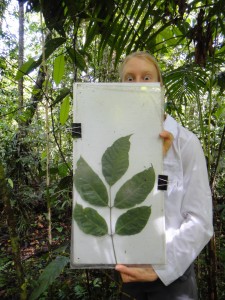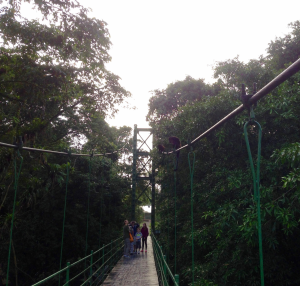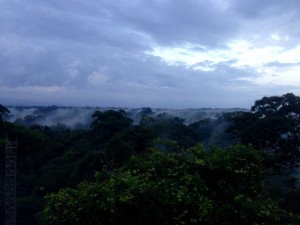It’s Wednesday night, July 23, 2014. I am sitting with Cleo Chou – a Ph.D candidate and my summer mentor – on the porch of La Selva Biological Research Station in Costa Rica. We are taking slow, musing bites of leftover birthday cake and talking through a problem.

Among other things, while in the field, we’ve been taking photos of the leaves of Cleo’s study trees. The goal? To determine the leaves’ size using a jerry-rigged computer analysis. I had taken advantage of our one non-field day this week to use the lab’s leaf area meter to check the accuracy of the computer program. Unfortunately, it turns out our calculated areas aren’t very accurate at all, and we don’t know why. Does the digital camera warp the photos? Is there something wrong with how we’re scaling them in the processor? The nocturnal forest chorus of cicadas and frogs is a soothing background to a worrisome problem. Every day we work in the field, more photos accumulate. It will already be an analysis marathon, but now we are additionally pursued by the specter of inaccuracy, the fear that our fastidious, hard-won photo samples will not tell us anything meaningful at all.
All this was on my mind when I headed out for a run on Thursday with my new running buddy, Connor. He’s an undergrad studying spider behavior, trying to find out if associations – when spiders’ webs connect – enhance spiders’ knowledge of their surroundings. Connor explained his experimental setup with excitement. However, he is finding spiders might not learn more from connections to their neighbors. Actually, apparently spiders are pretty aloof, and most of the time don’t respond to stimuli at all. In the meantime, Connor is scrutinizing completely motionless arachnids, waiting for something to happen.
“Six weeks into this project, I just feel frustrated,” he said. “The questions are fascinating, but in practice, animal behavior is often a really boring, unsatisfying field.”
“I thought that was what science was all about,” I said. Research is learning to love the tedium that lies between an exciting question and its exciting answer.

Connor agreed. “A bad day for me here involves shouting matches with howler monkeys. It’s amazing, and I love it. The frustration is part of it – it’s how you know you really care. And it can also lead to your greatest breakthroughs, when you feel like nothing makes sense, and then realize that you’ve been looking at the whole thing backwards.”
The confusion, frustration and disorientation of research is not just an obstacle but also a source of new ideas, better questions, and unexpected answers. I keep hoping for that, esperando – the beautiful Spanish word that means both waiting and hoping – that one of these days I’ll figure out how to troubleshoot our leaf-area photo analysis within an acceptable range of error.
On the way back to the station, Connor and I heard the sudden barking of howler monkeys – now a familiar sound – from the trees just overhead. We stopped running to look, and Connor started howling back at them, with a loud, deep-throated woof. The monkey responded immediately, echoing and outdoing him in a vocal territorial defense. I try it, too, the guttural bark mostly eluding me, but still eliciting a quick response from the howler alpha-male.

Forest life has its challenges: long days, unexplained bug bites, my perpetually-soggy running shoes…but it also has its fabulous, breathtaking, jaw-dropping perks: howling monkeys, glimmering insects, and beautiful breezy forest afternoons like today’s. I don’t know exactly where this journey is taking me, but I do know I’m excited to head out to the field again tomorrow. I hope we encounter some monkeys so I can show Cleo my new howling skills, and I hope we reach our goal – a sampling record of 25 trees a day.
This, to me, is what makes research worthwhile: the opportunity to immerse ourselves in real problems and real confusion, until, realizing we’ve been seeing the whole question backwards, we find a way forward. Science is frustrating, I thought last night, scrolling through a spreadsheet of inexplicable leaf-area measurements. But the true, good work is ahead, in working though the challenge in search of truth.
This is just the beginning of the best part.
– Zoe Sims, Natural Sciences Correspondent

